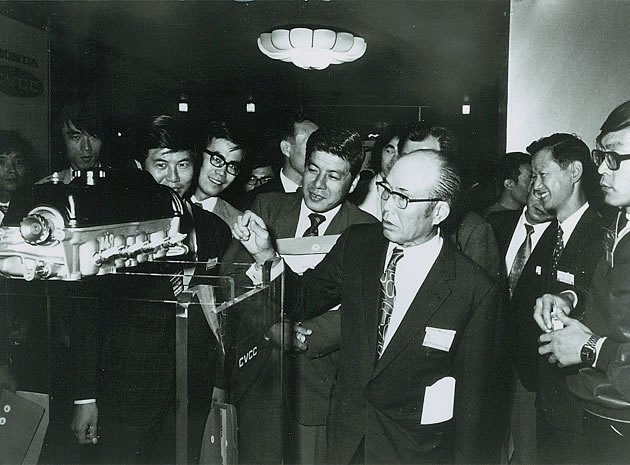Memoirs Of An Independent Repair Shop Owner: How Honda's CVCC Gave Me My 10 Best Years
This entry could very well have been included in the last series of articles (“Phil’s Podium of the Automotive Pure”), but for one important consideration: the technology involved is no longer being widely used in the automotive field. Otherwise, it solidly qualifies for “The Podium” in every other important aspect. The truth is, this technology is greatly significant in the history of the automobile—even surpassing many of the technologies listed.
Back in the early days of emissions control here in the U.S.A., in the wake of the first so-called “Energy Crisis”, which left motorists calling for more fuel economy in their automobiles due to the increased cost of fuel (if we only knew where all of THAT mess was headed!), I’d almost call it “amusing” witnessing all of the different ways manufacturers were addressing the issues.
The U.S. group, which seemed to be relying on input from “bean counters” and marketing strategists, was trying to make the old inefficient designs passable through use of a cheap and spindly patchwork of detuning modifications, add-on systems, and gargantuan catalytic converters.
The Europeans, who seemed to be actually raging somewhat at these governmental and motorist-driven demands, responded similarly as they did to the whole Air Conditioning issue, in earlier days. They went with the whole patch-and-add-on idea, but one-upped the Yanks by making their systems overly complicated, by comparison, as well as being a real obstruction to routine maintenance accessibility. They differed completely in their approach to catalytic converter use, opting initially to use the so-called “Thermal Reactor” exhaust manifold design, which were as unreliable as the first volley of catalyst systems the Yanks were using, not to mention a lot more expensive to replace.
The Japanese, on the other hand, were already positioned—more by developmental circumstances than actual foresight—to take advantage of the situation as far as the fuel efficiency issue.
As far as the emissions issue, they were somewhat fragmented in their approach.
As it turned out, Honda had a design they had been developing in the course of their foray into the passenger car field. It was called Compound Vortex Controlled Combustion—acronym: “CVCC”. While this design was not necessarily unheard of in automotive engineering circles, they were the only ones who wanted to actually be able to use it on mass-produced vehicles, where its full potential as a fuel economy and emissions breakthrough could be realized. And was it EVER!
It was so good, Honda was able to avoid the use of many add-on emissions control components common to the day. In fact, a catalytic converter was not required on any of their U.S. vehicles until 1980, and no engine management computer of any kind was seen until the 1984 model year (a feedback intake air-bleed system).
Fuel economy was nothing short of incredible, and has only been MATCHED by some of the modern hybrid Japanese entries (including Honda’s). Keep in mind that all of this was accomplished with a CARBURETOR and NO COMPUTER CONTROL!
We techs really appreciated these facts, as we saw only modest changes in underhood technology during the decade-long heyday of these engines. It was the best ten years of my automotive repair career, HANDS-DOWN!
It seemed that Honda was the lone problem-solving “Eagle” soaring above the rest of the grounded, whining and recalcitrant “Turkeys”; and Honda built its legendary reputation during this period. They continued to soar with the CVCC engine and the carburetor until the late ‘80’s, when EFI technology finally came of age, and has become the industry standard.
It’s ironic that what was accomplished by this upstart, one-time motorized bicycle manufacturing company more than thirty years ago—and was pushed aside and supplanted by a number of somewhat questionable automotive trends—is once again in demand.
Honda’s official history of the CVCC can be found here – Ed
Phil Coconis is the owner of a West Coast independent auto repair shop.
More by Phil Coconis
Latest Car Reviews
Read moreLatest Product Reviews
Read moreRecent Comments
- Dwford I don't think price is the real issue. Plenty of people buy $40-50k gas vehicles every year. It's the functionality. People are worried about range and the ability to easily and quickly recharge. Also, if you want to buy an EV these days, you are mostly limited to midsize 5 passenger crossovers. How about some body style variety??
- SCE to AUX The nose went from terrible to weird.
- Chris P Bacon I'm not a fan of either, but if I had to choose, it would be the RAV. It's built for the long run with a NA engine and an 8 speed transmission. The Honda with a turbo and CVT might still last as long, but maintenance is going to cost more to get to 200000 miles for sure. The Honda is built for the first owner to lease and give back in 36 months. The Toyota is built to own and pass down.
- Dwford Ford's management change their plans like they change their underwear. Where were all the prototypes of the larger EVs that were supposed to come out next year? Or for the next gen EV truck? Nowhere to be seen. Now those vaporware models are on the back burner to pursue cheaper models. Yeah, ok.
- Wjtinfwb My comment about "missing the mark" was directed at, of the mentioned cars, none created huge demand or excitement once they were introduced. All three had some cool aspects; Thunderbird was pretty good exterior, let down by the Lincoln LS dash and the fairly weak 3.9L V8 at launch. The Prowler was super cool and unique, only the little nerf bumpers spoiled the exterior and of course the V6 was a huge letdown. SSR had the beans, but in my opinion was spoiled by the tonneau cover over the bed. Remove the cover, finish the bed with some teak or walnut and I think it could have been more appealing. All three were targeting a very small market (expensive 2-seaters without a prestige badge) which probably contributed. The PT Cruiser succeeded in this space by being both more practical and cheap. Of the three, I'd still like to have a Thunderbird in my garage in a classic color like the silver/green metallic offered in the later years.





































Comments
Join the conversation
VW got smart in that era also. The Bosch CIS (K-Jetronic) fuel injection system introduce in 1977 was delightfully simple and kept the vacuum line plumbing to a minimum as well as allowing pre 1980 cars to run without a cat. This shows up clearly if you contrast a 1984 Jetta with a 1984 Accord, since my family had both.
To all commenters: It seems that I've struck a nerve with many on this topic. Stay tuned for the next "Memoirs" entry, where I'll provide rebuttal. Cheers!